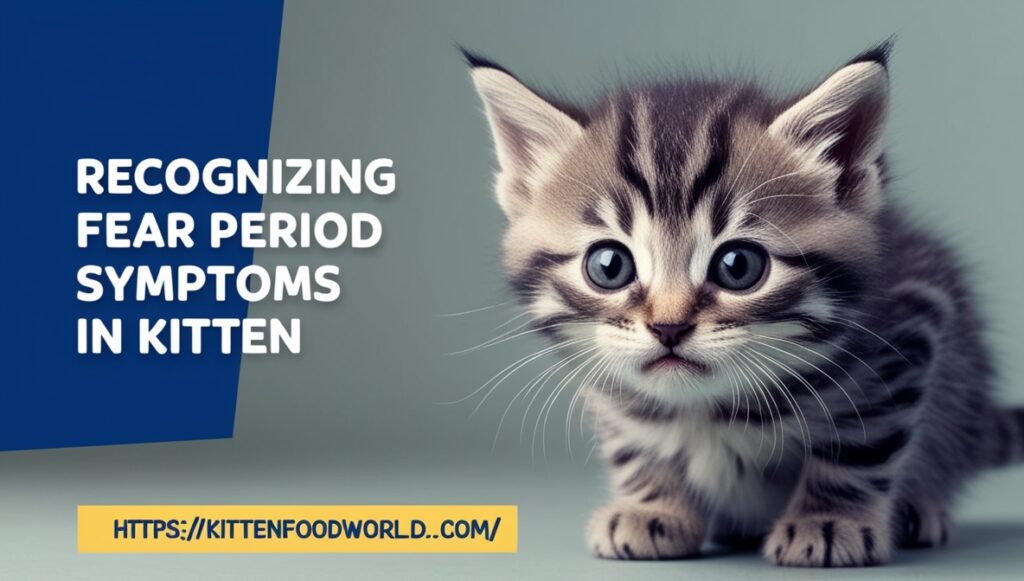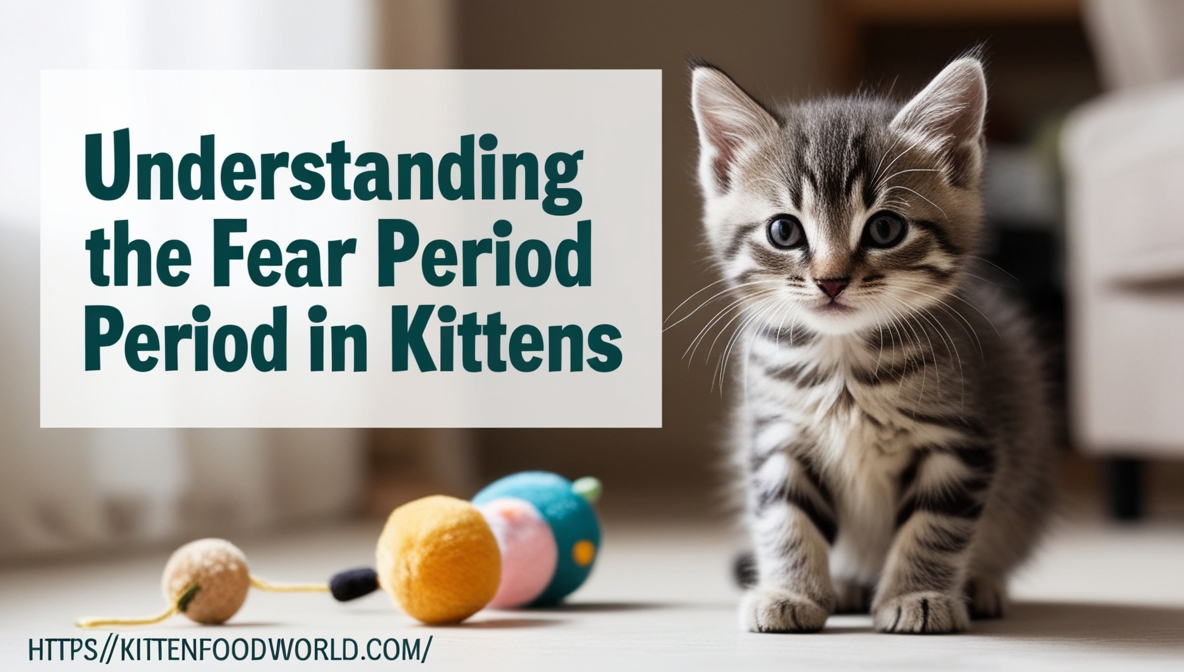Understanding the Fear Period in Kittens: A Complete Guide
Table of Contents
If you’re a new kitten parent, you may notice that your playful fur ball can sometimes show signs of fear, and anxiety that you weren’t expecting. What you’re likely seeing is called the fear period kittens, a developmental phase that nearly every kitten experiences.
In this guide, we’ll dive into everything you need to know about the fear period, from identifying symptoms to learning effective ways to help your kitten through it. Let’s make sure you’re ready to help your kitten grow up feeling confident, secure, and well-socialized.
What is the Fear Period in Kittens?

The fear period in kittens is a normal developmental stage, usually occurring between 8 and 16 weeks of age.
During this time, a kitten’s brain is highly sensitive to new experiences. Because of their heightened awareness, they may react more strongly to anything unfamiliar. This phase is an essential part of a kitten’s growth, and understanding it can prevent future behavioral challenges.
It’s helpful to think of this phase as similar to the critical socialization period for puppies, but for our feline friends. Just as puppies have a window of time to learn about their environment, so do kittens. Proper socialization during the kitten’s early life can significantly reduce anxiety and fear later on.
Why Does the Fear Period in kittens Happen?

The fear period happens as kittens become more aware of their surroundings. Evolutionarily, this behavior helps protect them from potential dangers in the wild. Even in a safe home, kittens may still feel threatened by loud noises, strangers, or sudden movements.
Without positive social experiences, kittens can grow into unsocialized cats, which may show fearful or aggressive behavior. During this period, new experiences can feel overwhelming, and a lack of gentle exposure to different sights, sounds, and smells can cause lasting fear-based behaviors.
Recognizing Symptoms Fear Period in Kittens

Identifying fear period symptoms is essential for pet parents. You may notice your kitten hiding more often, hissing, or even running away from things that didn’t bother them before. Common symptoms include:
- Increased hiding: Your kitten may suddenly retreat to safe spaces more frequently.
- Hissing or growling: Uncharacteristic vocalizations when they’re scared.
- Refusal to eat: Fear can sometimes lead to a decreased appetite.
These symptoms are natural and, with the right approach, temporary. By recognizing these signs, you can help your kitten feel more at ease during this phase.
How Can We Reduce or Eliminate the Fear Period in Kittens?

Understanding the fear period kittens and actively working to reduce its impact can make a significant difference in your kitten’s social development. Here are some key strategies to help your kitten feel secure and build confidence:
Early Positive Exposure
Introducing your kitten to various people, sounds, and gentle handling during this phase is crucial. Positive exposure allows the kitten to become familiar with everyday sights and sounds, reducing the likelihood of fear in the future. Make sure these introductions are gradual to avoid overwhelming the kitten.
Gentle Socialization
Spend time daily engaging in positive interactions with your kitten. Allow them to approach at their own pace, rewarding them with treats and gentle petting. Socialization during this period helps kittens build trust in their surroundings and people, which is essential for reducing fear-related behaviors.
Controlled Environment
Keep your kitten in a safe, controlled environment during this period. Avoid sudden loud noises, and ensure that any new interactions—such as meeting other pets—are calm and supervised. A stable environment helps kittens feel secure and reduces stress-induced fear.
Calming Tools and Techniques
Using pheromone diffusers, like Feliway, can help create a comforting atmosphere. Playing soft, soothing music and providing cozy, secluded areas can further alleviate anxiety. These calming tools support your kitten’s emotional well-being, helping them overcome fear more readily.
Patience and Consistency
Overcoming the fear period is a gradual process. Be patient and consistent in your approach, reinforcing calm and positive behaviors while avoiding any forceful interactions. Consistency reassures the kitten, making them feel safer and more at ease over time.
Seek Professional Help if Needed
In cases where a kitten shows extreme fear or anxiety, consulting with a veterinarian or feline behaviorist can provide additional strategies. Professional advice can help tailor interventions specific to your kitten’s needs, ensuring they progress healthily beyond the fear period.
How the Fear Period in Kittens Impacts Behavior?

During the fear period, your kitten may seem more timid and less social than usual. For some kittens, this phase includes a decreased willingness to interact with humans or other pets. They might become startled easily or react defensively. It’s essential to be patient during this phase, as your reactions can significantly influence their behavior going forward.
This period is also a time when your kitten is learning what is safe and what isn’t. The way they respond to their environment — including other pets, loud noises, and new people — can set the stage for their behavior in adulthood. Kitten socialization classes, whether online or in-person, can provide structured support during this time.
How Long Does the Fear Period in kittens Last?

The length of the fear period varies. Generally, it lasts between a few weeks to a couple of months, but every kitten is unique. Some kittens may go through this phase quickly, while others may need more time to adjust. Throughout this period, remember that patience and gentle guidance are key.
It’s worth noting that the socialization window for kittens generally closes around 16 weeks of age. After this, your kitten’s personality and behaviors tend to become more fixed. That’s why early socialization is crucial; during this window, they’re more receptive to new experiences and can build a foundation for confidence.
The Kitten Socialization Chart

To make socialization easier, many pet experts use a kitten socialization chart. This chart outlines the stages of development and highlights the best time for introducing new experiences. While there isn’t a universal chart for every kitten, you can find excellent resources and even a kitten socialization chart PDF online to guide you through each stage.
The chart typically suggests activities like:
- Handling: Gentle handling helps them get used to human touch.
- Exposure to sounds: Introducing soft music or common household noises.
- Interaction with other pets: Supervising gentle encounters with other cats or pets.
How to Socialize Your Kitten During the Fear Period in kittens?

Socialization is the foundation of a well-adjusted adult cat. During the fear period, you want to expose your kitten to a range of safe, positive experiences to help them build confidence. Here are some steps you can take:
- Handle them daily: Gently pet and hold your kitten so they learn to trust human touch.
- Introduce safe environments: Allow your kitten to explore a room or space with supervision, and gradually expand their range.
- Encourage positive experiences: Use treats or gentle play to make new experiences enjoyable.
If you’re unsure where to start, consider enrolling in free kitten socialization classes. These can provide structured support to help guide your efforts.
Kitten Socialization Classes Near Me and Online Options

If you’re looking for structured guidance, kitten socialization classes are a fantastic resource. Local options can offer in-person socialization sessions, while online classes often provide virtual support and resources tailored to kitten behavior. You can search for kitten classes near me or online kitten socialization classes to find a program that fits your needs.
Classes typically cover basic socialization practices, positive reinforcement techniques, and tips for handling fearful behavior.
How to Socialize Scared Kittens

For kittens that are particularly fearful, socialization may require extra patience. Here are a few ways to help a scared kitten feel more secure:
- Respect their boundaries: Give them space if they’re not ready to interact.
- Use calming voices and slow movements: Sudden movements can startle a fearful kitten.
- Provide safe hiding spots: Make sure they have places to retreat to when they’re feeling overwhelmed.
Taking a gradual approach will help them build confidence at their own pace, which is essential for fostering trust.
The Importance of the Kitten Socialization Window

The kitten socialization window is a limited time frame where kittens are naturally more open to new experiences. This period is generally up to 16 weeks, but early socialization (before 12 weeks) has the most lasting impact.
During this window, expose your kitten to various people, sounds, and situations to help them become well-adjusted adults. Missed socialization opportunities can lead to an unsocialized kitten that may struggle with anxiety or aggression later on.
How to Tell If a Kitten is Socialized

Recognizing the signs of a socialized kitten is important. A well-socialized kitten will:
- Approach people confidently: They won’t run away or hide.
- Be comfortable with handling: They don’t squirm or bite when held.
- Adapt to new environments: They explore rather than hide.
If your kitten meets these signs, you’ve successfully supported them through their socialization phase. If not, continue socialization efforts, as it’s never too late to improve their confidence.
Additional Resources for Kitten Socialization
If you’re seeking more support, there are plenty of resources to explore. Many animal behaviorists and cat-specific trainers offer kitten socialization classes that guide you through common challenges, like how to socialize your kitten with humans and other pets. You can also download resources like a kitten socialization chart by age to help you track your kitten’s progress.
For those who need extra guidance, consult with a vet or a certified pet behaviorist who can provide tailored advice based on your kitten’s unique needs.
Conclusion
Helping your kitten through the fear period is a rewarding experience that sets them up for a lifetime of positive interactions and confident behavior. By recognizing the signs, respecting their boundaries, and using proven socialization techniques, you can guide your kitten through this phase with love and patience.
For more in-depth information on this topic, check out the full guide on can adult cats eat kitten food at Kitten Food World.
FAQs on the Fear Period in Kittens
What is the fear period in kittens?
The fear period is a developmental stage in kittens, typically occurring between 6 to 14 weeks of age. During this time, kittens become more aware of their surroundings and may react fearfully to new experiences, objects, or people.
When does the fear period in kittens start?
The fear period usually begins around 6 weeks of age and can last until they are 14 weeks old. It is a natural phase in their development.
Why do kittens go through a fear period?
Kittens experience the fear period as part of their survival instincts. It helps them learn to be cautious and avoid potentially dangerous situations in the wild.
How can I identify if my kitten is in the fear period?
Signs of the fear period include hiding, hissing, avoiding interaction, or being startled by sudden movements or noises. They may also be less playful or curious than usual.
Is the fear period normal for all kittens?
Yes, the fear period is a normal developmental phase for all kittens. However, the intensity and duration can vary depending on the kitten’s genetics, environment, and prior experiences.
How long does the fear period last in kittens?
The fear period typically lasts for a few weeks, from about 6 to 14 weeks of age. However, some kittens may show fearful behaviors for longer if they lack proper socialization.
Can the fear period affect a kitten’s personality?
Yes, the fear period can shape a kitten’s personality if they experience significant trauma or lack socialization during this time. Proper handling and positive experiences can mitigate long-term effects.
How can I help my kitten during the fear period?
To help your kitten, provide a safe and calm environment, avoid forcing interactions, and expose them gradually to new experiences. Positive reinforcement with treats and praise can also build their confidence.
Should I avoid socializing my kitten during the fear period?
No, you should continue socializing your kitten, but do so gently and at their pace. Avoid overwhelming them with too many new experiences at once.
What should I avoid doing during my kitten’s fear period?
Avoid scolding, forcing them into situations they find scary, or exposing them to loud noises and aggressive interactions. These can exacerbate their fear and lead to long-term anxiety.
Can the fear period recur in older kittens?
While the main fear period occurs between 6 to 14 weeks, kittens may go through secondary fear phases later, especially during significant developmental milestones.
Is the fear period the same for all breeds of kittens?
The fear period occurs in all breeds, but the intensity may vary. Some breeds, like Siamese or Ragdolls, may be more sensitive during this time due to their genetic temperament.
What happens if a kitten is not socialized during the fear period?
Kittens that are not socialized during the fear period may develop lasting fears, anxieties, or become less adaptable to new environments and people as they grow older.
Can I train my kitten during the fear period?
Yes, you can train your kitten during this period, but focus on gentle, positive reinforcement methods. Training should be a stress-free and rewarding experience for them.
Are there long-term effects of a poorly managed fear period?
Yes, if a kitten experiences trauma or insufficient socialization during the fear period, they may develop phobias, aggression, or chronic anxiety in adulthood.
Can multiple kittens in the same litter experience different fear periods?
Yes, each kitten is unique and may experience the fear period differently, even within the same litter. Individual temperament and environmental factors play a role.
How can I socialize a shy kitten during the fear period?
Start by creating a quiet, safe space for the kitten. Gradually introduce them to new experiences, such as gentle handling, soft voices, and toys. Use treats to reward positive interactions.
Should I consult a vet if my kitten’s fear persists?
Yes, if your kitten’s fear persists beyond the typical period or seems extreme, consult a veterinarian or a behaviorist. They can provide guidance and assess for underlying issues.
How can I introduce my kitten to new people during the fear period?
Introduce new people gradually. Ask them to sit quietly and allow the kitten to approach on their own terms. Offering treats can help create a positive association.
What are some calming techniques for kittens during the fear period?
Calming techniques include providing a quiet and safe environment, using pheromone diffusers, offering hiding spots, and maintaining a consistent routine to reduce stress.







